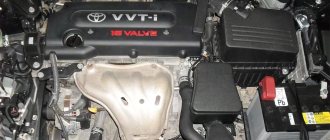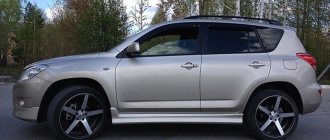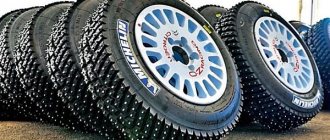Toyota Motor Corporation is the largest automobile manufacturer not only in Japan, but throughout the world. It produces about two hundred cars of various brands, and one of the most popular is the Toyota Camry.
This is a front-wheel drive sedan of the “E” class, very popular not only in families with a decent income, but also as company cars for various ranks of officials and business people. The reason for this is the incredibly elegant exterior, which immediately declares the respectability of the owner.
What kind of wheels are installed on a Toyota Camry so as not to disturb the driving performance of the car and not spoil the overall impression?
What sizes are suitable
Wheels on a Camry can have different sizes depending on the year of manufacture, body type, and configuration. First of all, you need to see what radius the wheels are installed on your car. If they are factory and you did not change them to other sizes yourself, then the parameters of the Camry V50 wheels will be as follows: 205/65R16 94S, 215/55R17 93 V, 225/45R18 91 V.
The disc on the Camry V50 radius 17 is the most common. It meets the standards of ease of use and has an attractive appearance. With such wheels (radius 17) the car looks most proportional.
For Camry 40, produced from 2006 to 2011, the standard parameters are 215/60R16; tuned wheels with tires of sizes 215/55 R17, 235/45 R18 are also suitable.
Characteristics of wheels for Toyota Camry
Over the years, the Japanese concern, which regularly updated its famous business class, improved the chassis, exterior, and equipping the car with electronic systems, but the overall base and wheel size on the Toyota Camry remained virtually unchanged for more than 35 years. Thus, the sizes of wheels and tires, depending on the modification and year of manufacture of the vehicle, had the following geometric parameters:
Wheels on Camry 4th generation
- Over the years, the wheel bolt pattern for Camry has changed only once and not so dramatically, since the wheels were always attached to 5 studs, and the circle on which the holes for them were located had a diameter of 100 mm in the 1st and 2nd generation of the model. Starting from modification 3 and until today, the drilling indicator has acquired a standard size for such cars - 114.3 mm.
- The diameter of the central hole with a bolt pattern of 5x100 was 54.1 mm, and with an indicator of 5x114.3 it increased to 60.1 mm.
- As for the size, in the 80s and 90s of the last century, almost all cars of famous brands had small diameters, and for the first modifications of the Camry this figure was R14 and R15. Since 1994, the sedan began to be equipped with 16-inch wheels in a luxury version, and with the advent of the 21st century, the 6th, 7th, 8th and 9th generations began to be produced in a wider range of different configurations with wheels of 16, 17, 18 and even 19 inches.
The presence of all-wheel drive in almost all trim levels allows you to operate the Camry both on smooth asphalt in a big city and on dirt roads in rural areas; the most universal dimensions are 16 or 17 inches.
The tires on such wheels have a profile height of 55 or 60 mm, which provides a large air buffer and increases driver comfort in the cabin when driving. In addition, this wheel size is ideal for installing all-season tires, which relieves motorists of the obligation to annually re-shoe their “iron horses”.
- The rim width also did not exceed 5J or 6J in the 80s and early 90s, but today anyone can purchase a Japanese business class with huge 7J or 8J wheels.
You may be interested in this Dimensions and parameters of wheels for Toyota Camry
Tires for Camry 5th generation
- If you analyze the wheel offset, or ET indicator, you can see that the brand has always presented its sedan with a conservative exterior, in which comfort prevailed over spectacular appearance. Thus, the disc offset was always an impressive 40-50 mm, which provided the wheels with a deep seat under the wheel arches of the body.
- Regardless of the place of production (the first models were assembled in Japan, and in 2007 their mass production began in the Leningrad region of the Russian Federation) and generation, all cars were equipped with summer tires with a range of sizes from 185/70/R14 in 1982 to 235/40/ R19 - for 9th modification of Camry.
Important!
Of course, in 2021 there are very few cars from the 80s and 90s left in operation, but almost all models of the last 3 generations are widely found throughout the country, and given the universality of the recommended parameters of wheels and tires, drivers do not experience difficulties in choosing these products if a problem arises. need for replacement.
Exclusive wheels on Camry XV70
How are winter tires different from others?
Winter tires for Toyota Camry must be specially designed for winter operating conditions. Not only does it have a different tread, but it is also able to withstand low temperatures due to its special composition. If at sub-zero temperatures a summer tire becomes hard or begins to crumble and no longer holds the road, then such troubles do not occur with a winter tire.
Some tires for better traction can be equipped with studs, thanks to which they can better control the behavior of the car on a slippery, icy road, but studs are not always appropriate if you move mainly on asphalt, where frozen, ice- and snow-covered areas only occasionally come across.
Rating of the best tire manufacturers for Toyota Camry V50
Among all the Camry modifications, Russian car enthusiasts liked the 8th generation of the brand the most, which underwent 2 facelifts at once, as it was produced for 7 years - from 2011 to 2018. This generation had the body code V50 (XV50), and over the entire period of operation of the conveyor, hundreds of thousands of copies were sold around the world, and among Russian car enthusiasts this model took one of the leading positions.
This trend continues to this day, and for potential consumers, hundreds of different brands offer different tires, differing in the country of manufacture, rubber composition, tread patterns, quality, reliability, wear resistance, load and speed indices, as well as the pricing policy set by the manufacturers. Thus, the main companies producing and selling tires in Russia, which have proven themselves more than others among Toyota Camry owners, are listed below:
- Of course, the oldest fans of the model, who have purchased cars that were delivered straight from Japan, often choose expensive tires from well-known world brands, and among them we can highlight products compatible with the latest generations of Camry - Goodyear Eagle Sport TZ, Dunlop Grandtrek PT3 or SP Sport FM800, Yokohama Geolandar A/TS, H/TS and SUV (for all-wheel drive versions).
- If the tires described above seem too expensive to the car owner, he can always consider tires from Korean brands that are not much inferior in quality. Thus, the most popular modifications of tires for the Toyota Camry V50 are Hankook Ventus ME01 K114 or Prime 3 K125, Toyo Open country U/T, H/T, Proxes CF2, CF2 SUV, R1R, as well as Tranpath MPZ.
- When a driver does not have the necessary budget at all or simply does not want to spend significant money on tires for his car, he can also consider products from numerous Chinese manufacturers, among which, undoubtedly, there are decent quality tires, for example, from the Tigar concern. The models of this company are all sizes of the High Performance series. The Triangle brand has also proven itself well in the Russian market, producing business-class tires TR978, TR918, TR968, TR967 and Sportex TSH11.
- Considering that for the last 13 years Camry has been assembled mainly in Russia, car enthusiasts can safely install time-tested, domestically produced tires on its various modifications. Among them, the most popular are Viatty, Matador or the Russian division of Nokian, whose products are the best option for winter tires for the Camry in terms of price-quality ratio.
What types of winter tires are there?
When deciding which winter tires are best to install on the Camry V50, you need to pay attention first of all to its quality. Winter tires on the Camry V50 can be with or without studs. Before making a choice, you need to weigh the pros and cons; each type of tire has certain advantages and disadvantages.
Rubber equipped with spikes is excellent for icy roads and snow-covered surfaces. On smooth asphalt, such tires will have poor grip on the road, and some of the studs may leave their places and get lost.
Winter tires for Toyota Camry
Winter tires for Toyota Camry
Experts recommend not waiting for the first frost or snow, but putting winter tires on your Toyota Camry as soon as the average air temperature does not exceed +5 degrees. But there is no particular need to rush - at temperatures above +9 degrees, rubber begins to lose its properties, which is why the braking distance increases significantly. And the comfort of the trip decreases - the contact of heated winter tires with the road causes a fairly high noise level.
Winter tires for Toyota Camry can be studded or studless.
Studded tires are ideal for driving on icy roads and roads covered with a thick layer of snow. If you are sure that in most cases you will have to fight the winter elements, then when choosing this type of tire, give preference to square studs rather than round ones.
Non-studded tires have higher quality characteristics than studded tires. The deep tread pattern allows the vehicle to have good grip not only on dry roads, but also when overcoming ice and snow drifts. Choose options with a tread depth of at least 9 mm - this will guarantee that even in bad weather you will not lose control of the car.
Features of non-studded tires
Winter tires for the Camry V50 and other cars are divided into Scandinavian and European classes. Their differences lie in the road they are designed for. European tires are designed for wet roads covered with unfrozen snow, they have a large number of channels for water, and are well suited for use not only in winter, but also in heavy rain. The Scandinavian type is distinguished by an aggressive tread, which is designed for traction with heavily frozen surfaces, snow or ice. Such tires are in great demand in Russia.
The studless option has the following features, regardless of what tread pattern it has: such tires are well suited for driving on dry asphalt, but you will not feel very comfortable on icy roads. There is a large selection of wheels with a radius of 17 on the market, so choosing tires from almost any manufacturer for the Camry will not be difficult.
Such tires can also be used in the summer: thanks to the universal composition, the rubber will not float and remain on the road surface. It makes much less noise than its analogue with spikes; there are no elements that will fall off when colliding with an unsuitable road surface.
Conclusion
When choosing tires for a Camry, you need to choose the right size (radius 17 would be optimal), decide where you will drive most often, get acquainted with the manufacturers, giving preference to the most reliable one from your point of view.
Source clubmashin.ru
Reading time: 7 minutes
Since Soviet times, many car enthusiasts from Russia have been in awe of the business class, and therefore this type of vehicle has been in stable and high demand. Since the early 90s of the last century, the Toyota Camry, the production of which began even earlier, in 1982, was recognized as one of the most popular representatives of the business class among domestic drivers, but at that time the model was not yet supplied to the country. Considering the reliability of the brand, today on the roads you can find not only the latest, 9th generation of Camry, but also earlier modifications, which often require repair and replacement of certain spare parts, including rims or tires.











